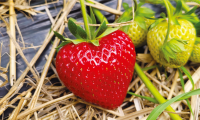...
Polka
Productivity:
4
Taste:
3
Earliness:
3
Disease resistance:
2
Shelf life:
2
Firmness:
2
Polka, the taste of the north. Polka is in mid to late season variety. The fruits of Polka are of average size, uniform in shape, intensely red and very good in flavour. The yield is high. Polka is especially used used for the fresh market in Scandinavia. It’s frost resistance plays an important role in it. Also it’s good taste is well appreciated there. Polka is very suitable for the fresh market and for making jam and juice.
Characteristics of Polka
• Excellent frost resistance
• Great taste
• Suitable for the fresh market and processing
Fruit quality
The fruits of Polka are shiny, have an intense dark red colour and are red on the inside. The strawberries have a pleasant sweet sour strawberry aroma. The taste is very good and the fruits are firm and conical. The size of the fruit is average, becoming smaller as the season lengthens. It is important the plants receive sufficient water to grow. The fruits are easy to pick, and if left on the plant a bit longer, it is also fairly easy to pick them without the crown.
Flowering and harvest periods
Polka plants are robust and somewhat closed. The flowers of Polka have well developed stamens that produce sufficient pollen for a perfect fruit set. The harvesting period is more or less equal to that of Elsanta.
Productivity
Polka is a productive variety, provided the fertilization and moisture supplies are well regulated.
Sensitivity of disease
The fruits of Polka are sensitive to fruit rot (Botrytis cinerea). The plants are sensitive to red core (Phytophthore fragariae) and moderately sensitive to crown rot (Phytophthora cactorum). Polka is quite resistant to mildew (Sphaerotheca macularis) and purple leaf spot (Alternaria alternata).
Cultivation experience
Polka has been developed for the processing industry as an alternative for Senga Sengana. However, Polka is especially used for the fresh market in Scandinavia. It’s frost resistance plays an important role in it. Polka fits well in growing systems in which the plants remain in the field for some years. Polka grows better in somewhat heavier soil.
For more information take a look at the flyer
Rijptijd tijdsbalk:








